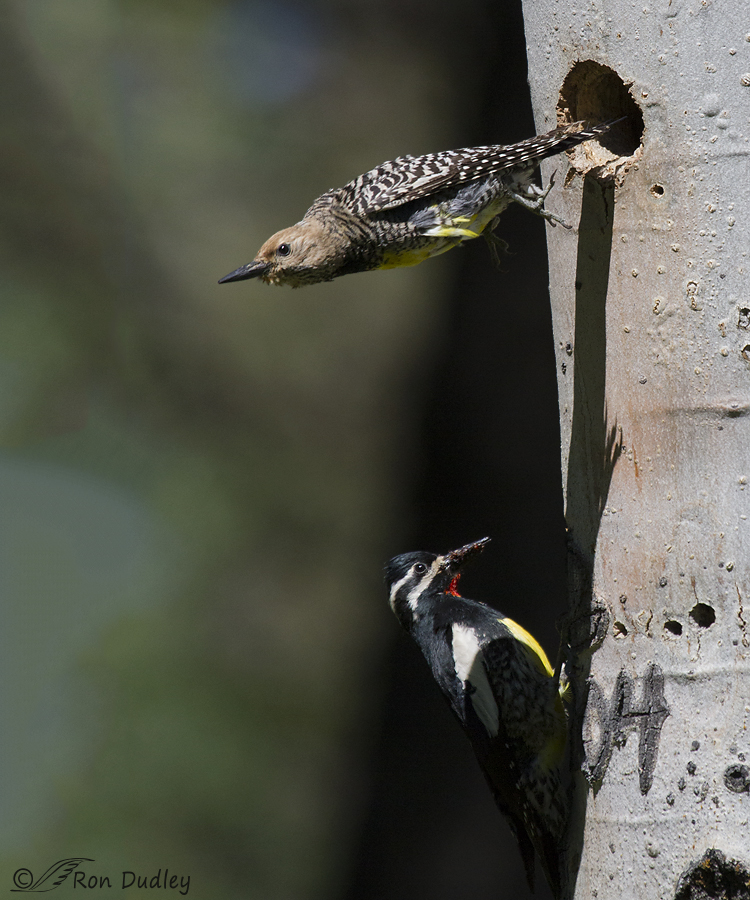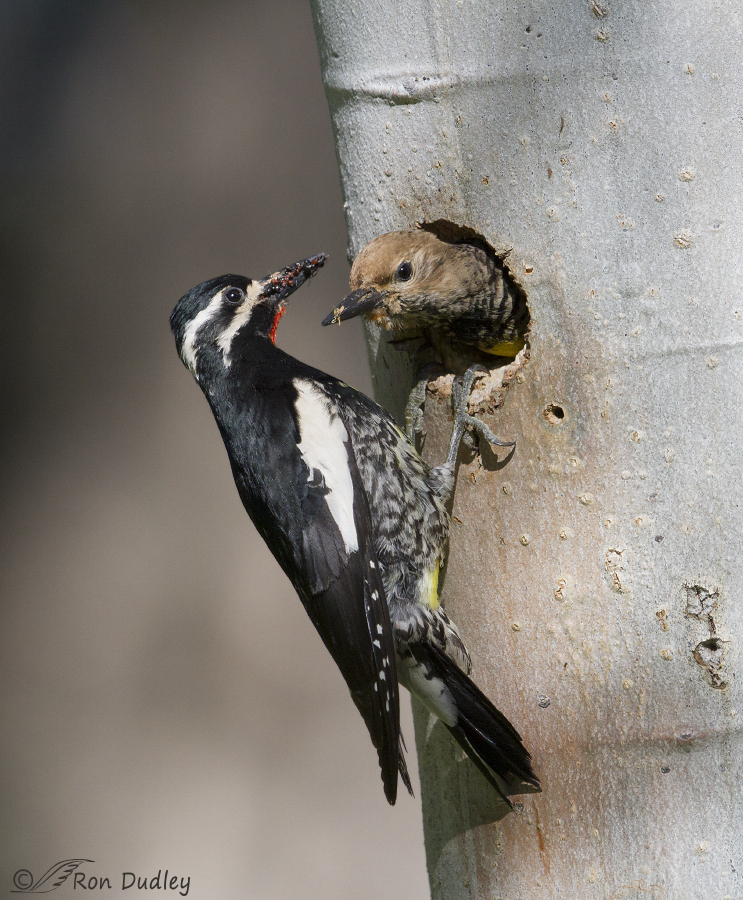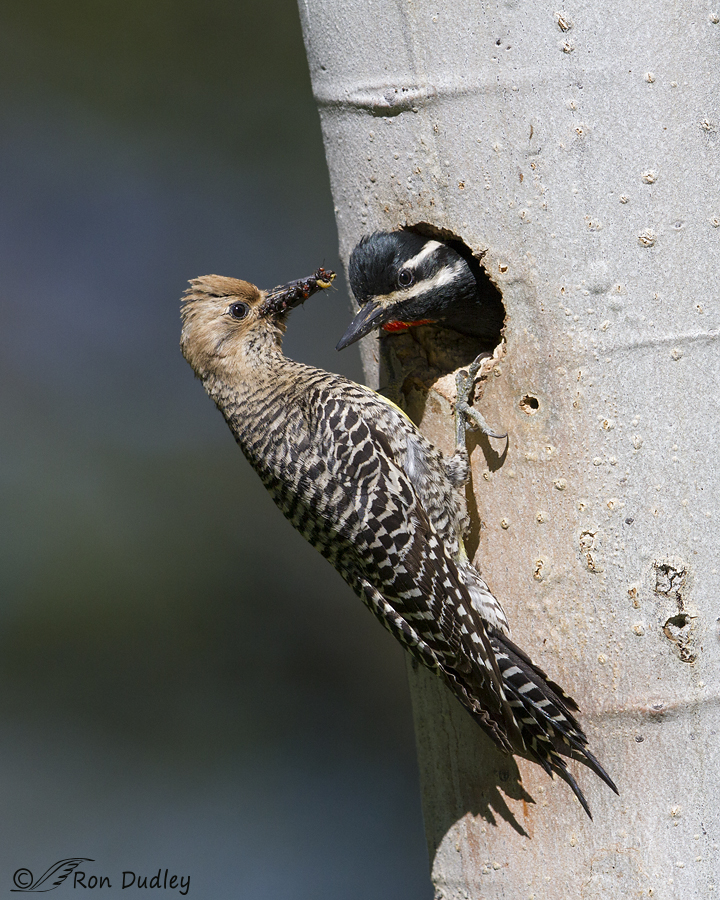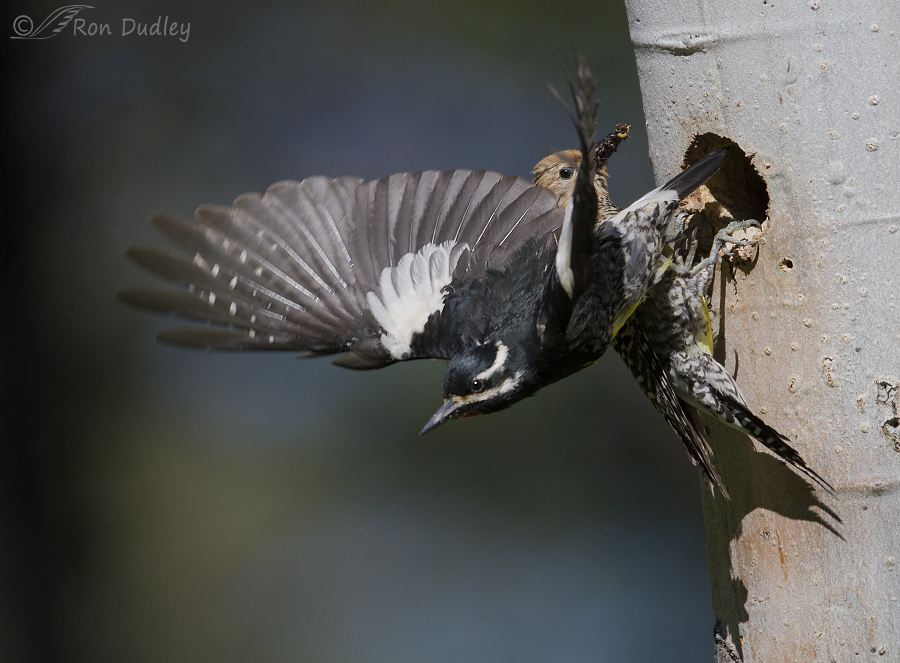We were very lucky to find the nesting pair of Williamson’s Sapsuckers in Clark County, Idaho early this summer. For starters, they’re “uncommon” and not often seen. Birders and researchers typically locate most birds by their calls but this sapsucker species is “generally quiet” and doesn’t spontaneously advertise their territories that time of year so passive listening tends to be ineffective in locating them. For this and other reasons Williamson’s Sapsuckers are poorly sampled and studied and there is little data on their numbers.
We first located the nest-hole in late May, thanks to the activity of House Wrens who were nesting in an adjacent hole in the tree that had also (apparently) been excavated by the sapsuckers. These photos were taken on our second trip to the area a month later (June 29 – July 1).

1/4000, f/6.3, ISO 800, Canon 7D, Canon EF100-400mm f/4.5-5.6L IS USM @ 370mm, canvas added for composition, not baited, set up or called in
While photographing the sapsuckers one of my goals was to catch both the male and the female in the same image as often as I could in order to highlight the unusual and striking differences in their plumage. It wasn’t easy and I was only moderately successful. They were busy feeding young in the nest so when one bird was out foraging for ants the other was usually in the nest-hole with the chicks. Typically the bird in the nest would wait for its mate to return with food and then they would exchange roles. It was during that exchange that I had my only chances to get both birds in the same photo.
Here the male has returned to the tree with a beak-full of ants for the chicks and the female is leaving on another foraging trip. I do wish her shadow hadn’t fallen on his side but at least there’s light on his head and torso. We called these kinds of images where the leaving birds wings haven’t yet opened “bullet shots”.
1/3200, f/5.6, ISO 500, Canon 7D, Canon EF500mm f/4L IS II USM, not baited, set up or called in
Sometimes the returning bird would wait below the hole for its mate to vacate the nest but other times that bird would wait at the hole entrance, which didn’t leave a lot of room at the hole for the leaving bird to get out. Here the female has leaned far to her left to give her mate room to make his escape.

1/3200, f/5.6, ISO 640, Canon 7D, Canon EF500mm f/4L IS II USM, not baited, set up or called in
In the end my favorite “two bird” shots of the sapsuckers didn’t include a full body view of both birds. Here the female is about to leave the hole and the male has brought in more ants. Note that he too is leaning to his left to give her room. The leaving birds exit is explosive and at times I thought it would take the other birds head off…

1/3200, f/5.6, ISO 500, Canon 7D, Canon EF500mm f/4L IS II USM, not baited, set up or called in
And in this image their roles are reversed. I really enjoy the intimate look at both birds at the nest-hole in the final two images.
Ron



Yes, the Evil,iPad and I have a very strange, very strained relationship…a recent example: I typed “many”, it typed “Kenya” (I JUST typed “type”, it typed “hope”!!!) I will find spellcheck.and zap it . I think hat’s what someone else told me to do…now I just have to figure out where the darned thing is and how to do it…BUT I WILL!!!
Patty, the place to look for spell check (at least on my Mac – I don’t have an iPad) is in the edit menu for your word processing program. It should be under ‘spelling & grammar’. If spell check is activated it will have a check mark next do it. All you should have to do is click on ‘check spelling as you type’ and that should take care of the problem. As I said, that’s how to do it on a Mac. I think the iPad should be somewhat similar. At least this should give you a place to start. Best of luck in your quest to conquer evil…
Stunning! I love them all, but perhaps the first two especially, there is so much energy in them.
I was very fortunate to be one of three birders who found and identified a female Williamson’s here on the Mendocino Coast a few years ago. It was only the second one recorded here; the first is a speciment collected in 1918 and kept in the California Academy of Sciences!
These images are absolutely wonderful. Catching the birds as they switch positions really makes me feel almost like I was there.
This may sound a bit cornball, but I find that the combination of the two birds together (last two images with one outside and one inside the nest hole) create an imperfect but symbolic heart shape of sorts. Maybe its my romantic side…..
How do you like the term “birdhographers”? I can’t claim credit for that one…The Evil iPad invented it all by itself! SOMETIMES it comes up with a keeper. It seems to do its “editing” immediately after I hit “send” . Someone once told me to turn off something so it couldn’t make up stuff, but I don’t remember what it was or how to do it….
You and your love/hate relationship with that Evil iPad make me smile Patty, though I know it’s very frustrating for you. I don’t know squat about iPads but I suspect if you turned off spell check your problem might be solved. Anytime you (or anyone else) wants me to edit comment typos on my end just ask and I’ll do it. You can ask by using the “contact me” tab at the top of my blog. I’m hesitant to do it without being asked because I don’t want to put words into anyone’s mouths. That can be a slippery slope…
It is like a projectile coming out of the tree.Really shows the pair at work.
They are exceptionally hard workers, Jane.
Oh my. Oh my, oh my. Speechless with wonder, with gratitude, with envy.
Thank you.
I figured you might enjoy some of these images, Elephant’s Child – even though there’s not a pantaloon or any britches in the bunch!
I am just greedy. Britches are wonderful – but not everything.
These are truly incredible photographs. The differences between the male and female and the interaction between them makes these photographs priceless.
I’m glad you enjoyed them, Angela.
A parent’s work is never done.
These shots are amazing!!! Never saw this specieis before. Your photos and exploanations are so interesting. The captures really make me want to peek inside to see the nest and babies!! Very nice Ron.
I’m always “tempted” to look inside nests too, Ellen but I’ve never done it. I’d love to take a peek in there but I guess I’ll just have to use my imagination. If I’m up there this fall after nesting season I’ll probably not be able to resist!
Great shots. It’s not only the skill, it is also the patience and timing that is needed to do such wonderful job. I agree with Patty it is a priceless material that deserves to be published.
Very very well done.
I guess it does take a lot of patience Jorge but I’m usually having so much fun that I don’t notice it. Good thing too because I’m generally not known for my patience…
Hi Ron,
Thank you for another lesson from The Field of Wonder. Great subjects, great images, great teacher. My resume states I am a continuous student of birds and birding – you are one of my favorite “professors”. Thanks again!
Cheers,
Dick
I’m a continuous student too, Dick – especially of birds. But thank you very much.
They are beautiful and I enjoy learning about them from you.
That’s a nice compliment for both me and the sapsuckers, Wendy. Thanks.
Once again, you have captured some incredible “comparison shots”!…Have you ever compiled some of these and shown them to a group like an Audubon chapter, any group of birders, bird photographers or college class? You are still very much a teacher…and a darned good one…and you have some priceless material to share.
Thanks, Patty. No, that’s something I haven’t done. I do know of teachers who use some of my blog posts in class though.
Stunning sensational shots Ron, thanks for sharing!
Charlotte
Thanks very much, Charlotte.
Ron the last two photos are spectacular to show the sexual dimorphism. Difficult to imagine how the bird leaving has enough room to get out . Lucky you seeing it real time. Thanks
Those last two are also my favorites, Diana. Since the sexes are so different (unique among North American sapsuckers) it’s easy to see how early researchers thought they were two different species.